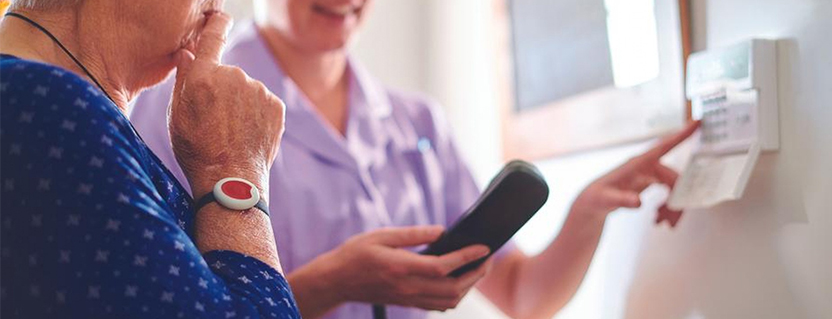Bluetooth low energy for assisted-living solutions
Compact size, low power demand, ubiquitous availability, and improved in-building coverage all make Bluetooth technology a perfect fit.
Many countries have seen COVID-19 push their healthcare system to its limits. The pandemic will one day subside. But even when it does, the healthcare sector will remain in deep water. Global population numbers, their average age, and the incidence of chronic disease are all pointing up, driving up demand for healthcare. At the same time, the healthcare spending continues to rise year on year, having already reached 10 percent of global GDP in 2018, according to WHO.
There are countless ways out of this predicament, but one thing is clear: technology will be central in all of them. And not only in clinics and medical research centers, but also in elderly homes and within people’s own four walls. Assisted-living solutions – a key ingredient in the mix – will continue to gain traction to preserve the freedom and autonomy of elderly and disabled people and other vulnerable populations.
What is assisted-living technology?
Assisted-living technology uses wireless communication, sensors, and local or cloud-based platforms to assist residents in their daily tasks, monitor their behavior, relay data back to their healthcare providers, and, in the case of an accident, automatically alert rescue services.
Smart assisted-living solutions are typically made up of a variety of components: sensors, devices, and one or several hubs and gateways.
Fixed sensors such as motion detectors, for instance, monitor room occupancy and other behavioral patterns, while body-worn sensors track anything from footsteps to falls to physiological parameters.
Fixed smart devices, on the other hand, include smart door locks, smart lighting systems, wireless personal assistants, indoor climate control, TVs, and smart domestic appliances. They can also include bedside medical devices such as medical-grade respirators to protect against sleep apnea.
These are complemented by body-worn devices, which can include blood glucose monitors and insulin pumps, wrist-worn emergency buttons, and more.
Finally, assisted-living solutions often comprise one or several wireless gateways that act as communication hubs to relay data and commands from one device to the other, and all the way up to the cloud.
Why Bluetooth low energy makes sense for assisted-living technology
Assisted-living solutions draw on a range of complementary wireless communication technologies. Wi-Fi offers high data transfer rates that are sufficient to stream high-resolution video. And cellular communication technology connects devices directly to the cloud without passing through a local network. Combined, they provide the technological redundancy gateways used for critical applications need to deal with temporary outages of one or the other communication channel.
Add to that Bluetooth low energy, which has already made a name for itself in healthcare applications, such as connected medical devices, thanks to its extremely low power requirements, immunity to interference, availability on basically every smartphone, computer, and IoT device on the market, and solid baseline security off the bat.
Bluetooth low energy is growing its niche in the assisted living technology and smart home arena with several new innovations. These include Bluetooth long range to increase in-building penetration, Bluetooth direction finding and indoor positioning for indoor location services, Bluetooth mesh to connected devices into dense many-to-many networks, and LE audio to broadcast synchronized audio streams to several devices.
NORA-B12 for more powerful, more secure, longer-range end devices
We recently released our NORA-B12 Bluetooth 5.2 low energy, Thread (IEEE 802.15.4), and Zigbee module – a reliable enabler of in-building wireless connectivity for a variety of assisted living and smart home applications. Like all other modules in the NORA-B1 series, NORA-B12 features a dual-core CPU with sufficient computing power to run complex applications and drive sophisticated graphical interfaces on its application core while executing the Bluetooth stack on the networking core.
Incorporating Arm’s TrustZone and Cryptocell-312, the NORA-B1 series takes the security of assisted living and smart home applications to the next level, protecting sensitive patient data without sacrificing performance. And compliance with the Matter standard, backed by Apple, Amazon, Google, and many other major brands ensures that devices can interoperate seamlessly into a growing ecosystem.
NORA-B12’s unique addition is a power amplifier designed to extend the reach of its wireless signal, in particular in buildings. By broadcasting a “louder” message, fixed and wearable smart devices can reliably relay information to gateways and wireless hubs and back.
To learn more about the NORA-B1 series, reach out to your nearest salesperson and, head over to the product page.
Pelle Svensson
Market Development Manager, Product Center Short Range Radio, u‑blox

